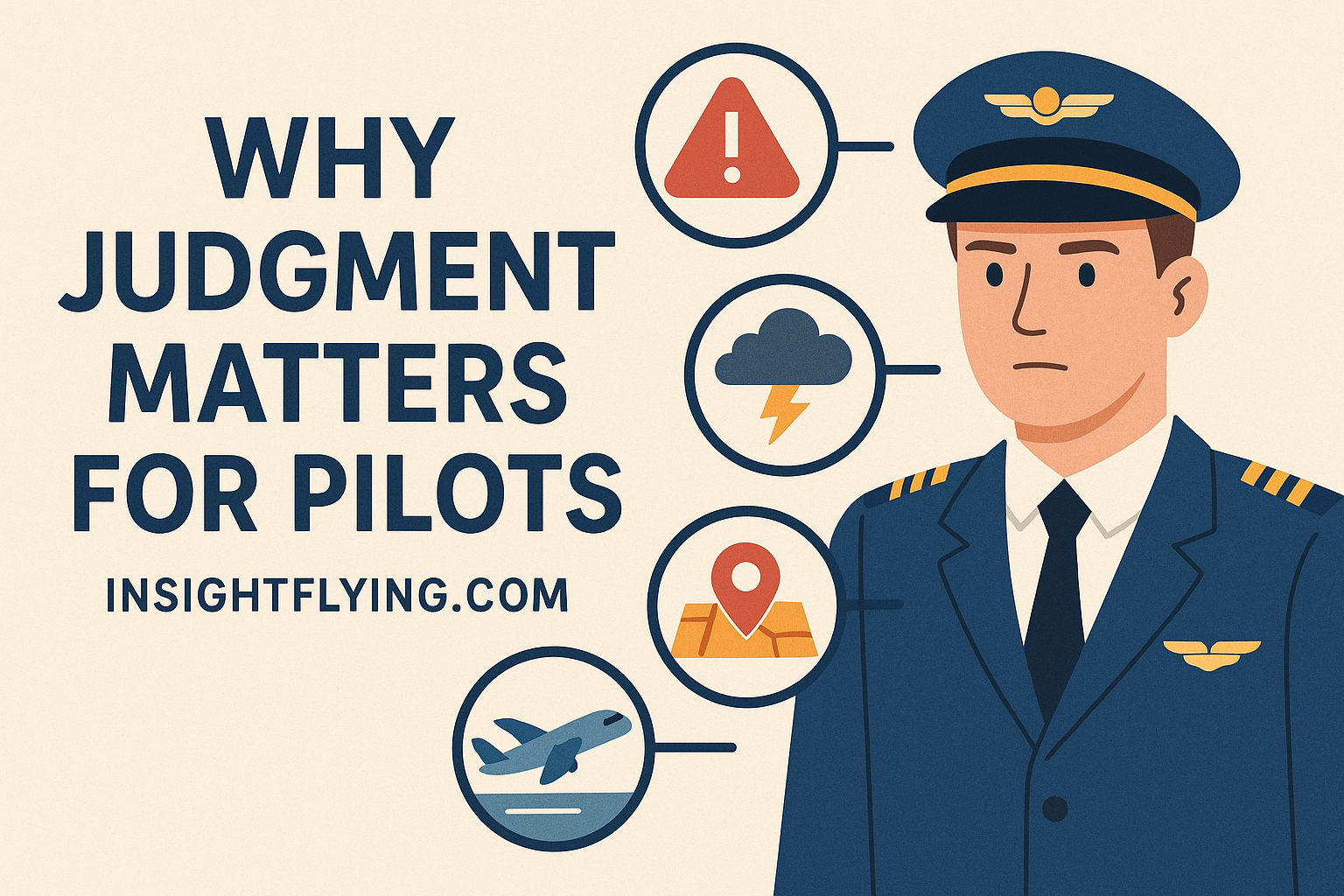Judgement คือ “ความสามารถในการตัดสินใจอย่างรอบคอบและสมเหตุสมผล” ซึ่งในงานนักบินไม่ใช่แค่ คิดเก่ง แต่ต้อง คิดถูกจังหวะ และ คิดเท่าที่จำเป็น—ภายใต้ข้อจำกัดของ เวลา ข้อมูลไม่สมบูรณ์ และผลกระทบที่อาจเกิดขึ้นจริ`’
“Really think of things before act.”
ในห้องสัมภาษณ์เพิ่มอีกข้อคือ
“Really think of things before act or speak.”
Judgement สำคัญอย่างไรสำหรับนักบิน
การตัดสินใจของนักบินมักถูกกำหนดโดยสองแกนหลัก:
- เวลา (Time Pressure) — มีเวลาคิดมากหรือน้อย?
- ผลกระทบ (Consequence/Seriousness) — ผิดแล้วกระทบมากน้อยแค่ไหน?
ยิ่ง เวลาน้อย + ผลกระทบสูง คุณยิ่งต้องมีกรอบคิดที่ชัดเจน รู้ว่าอะไรต้องทำก่อนอะไร (Priority) และกล้าตัดสินใจ
ในห้องสัมภาษณ์: คิดเมื่อไร ตอบเมื่อไร
ไม่ใช่ทุกคำถามต้อง “นั่งคิดนาน”
- คำถามข้อเท็จจริงพื้นฐาน (เช่น บ้านอยู่ไหน? จบที่ไหน?) — ตอบให้ตรง ชัด และทันที การชะงักนานทำให้เสียคะแนนด้านอื่น (ดูคล้ายไม่ตรงไปตรงมา/ไม่มั่นใจ)
- คำถามสถานการณ์/มีผลแพ้–ชนะชัดเจน (ถูก/ผิด ผลกระทบสูง) — เว้นจังหวะสั้น ๆ เพื่อจัดลำดับคิด แล้วค่อยตอบอย่างมีโครง
สังเกตง่าย: ถ้าคำถามมีผลลัพธ์ชัด ๆ แค่ “ถูกหรือผิด” และเสี่ยงเสียคะแนนสูง — ให้ช้าลงครึ่งจังหวะเพื่อคิดก่อนตอบ
กรอบคิด 30 วินาที เพื่อโชว์ Judgement
ใช้สูตรสั้น ๆ นี้ได้ทั้งในห้องสัมภาษณ์และงานจริง:
F-O-R-D
- F – Facts: สรุปข้อเท็จจริงสั้น ๆ ที่เกี่ยวข้อง
- O – Options: มีทางเลือกอะไรบ้าง (อย่างน้อย 2)
- R – Risks: ความเสี่ยง/ผลกระทบของแต่ละทางเลือก
- D – Decide: เลือกและบอกเหตุผล พร้อม Plan B ถ้าสถานการณ์เปลี่ยน
ประโยคตัวอย่างเวลาตอบ:
“จากข้อมูลที่มีตอนนี้คือ… (F)
ทางเลือกมี… (O) โดยความเสี่ยงคือ… (R)
ผม/ฉันจะเลือก… เพราะ… และถ้าสถานการณ์เปลี่ยนจะ… (D)”
หลักการบินที่แปลงมาใช้ตอบคำถาม
- Aviate – Navigate – Communicate: จัดลำดับก่อน–หลังให้ถูก (ความปลอดภัยก่อน)
- Use SOP/Checklist Mindset: อ้างอิงขั้นตอน/เหตุผล ไม่ใช่ความรู้สึกล้วน ๆ
- Timeboxing: ถ้าเวลาจำกัด ให้ “กำหนดเวลาในหัว” ว่าจะคิดกี่วินาที แล้วตัดสินใจ
ตัวอย่าง “คิดถูกจังหวะ” ในห้องสัมภาษณ์
- คำถามง่าย/พื้นฐาน
- “ที่อยู่ปัจจุบัน?” → ตอบทันที ชัด สั้น ไม่ต้องเล่นคำ
- คำถามสถานการณ์
- “ถ้าเจอสภาพอากาศแย่กว่าที่คาดบนเส้นทาง คุณทำอย่างไร?”
- F: เช็กเชื้อเพลิงทางเลือก / รายงานอากาศ / ข้อกำหนดขั้นต่ำ
- O: รอ / อ้อม / เบี่ยงเส้นทาง / เปลี่ยนปลายทาง
- R: เชื้อเพลิง/เวลา/ข้อจำกัดสนาม/ความปลอดภัยผู้โดยสาร
- D: เลือกทางที่ ปลอดภัยสุดภายใต้ข้อจำกัด และสื่อสารอย่างมีโครง
- คำถามกดดัน/ข้อมูลไม่ครบ
- “กัปตันให้ทำสิ่งที่คุณไม่มั่นใจว่าปลอดภัย คุณจะทำอย่างไร?”
- แสดงความเคารพต่ออำนาจสั่งการ + ยึดความปลอดภัยเป็นหลัก
- ขอข้อมูลเพิ่มอย่างสุภาพ ชี้ข้อกำหนด/วิธีทางเลือก และเสนอแนวทางที่ปลอดภัยกว่า

Do’s & Don’ts ของ Judgement ในการสัมภาษณ์
Do’s
- เว้นจังหวะสั้น ๆ ก่อนตอบคำถามใหญ่ (แสดง “think before speak”)
- โครงคำตอบชัด (Facts → Options → Risks → Decide)
- อธิบายเหตุผลที่เชื่อมกับความปลอดภัย ขั้นตอน และข้อจำกัดจริง
- มี Plan B เสมอ เมื่อสภาพแปรเปลี่ยน
Don’ts
- ไม่ยืดเยื้อกับคำถามพื้นฐาน
- ไม่เดาสุ่มแบบไม่มีโครงเหตุผล
- ไม่ยึด “ความกล้า” มากกว่า “ความปลอดภัย”
- ไม่ปักใจเชื่อทางเดียว—ต้องชั่งน้ำหนักความเสี่ยงก่อนเลือก
ในงานจริง: ทำไมยังต้องมี Judgement ทั้งที่มี Checklist?
SOP/Checklist ถูกออกแบบมาเพื่อลด Human Error และลดภาระการตัดสินใจในภาวะกดดัน แต่ ไม่มีขั้นตอนใดครอบคลุมทุกสถานการณ์ จึงยังต้องพึ่ง Judgement ของนักบิน ในการ “คิด วิเคราะห์ แยกแยะ” ก่อน “ตัดสินใจ” เสมอ
สรุปสั้นจำง่าย
- คิดให้ถูกเรื่อง ถูกเวลา ถูกปริมาณ
- ให้เหตุผลเป็นระบบ มากกว่าความเห็นส่วนตัว
- ปลอดภัยมาก่อนเสมอ—แล้วจึงประสิทธิภาพและความตรงเวลา
Judgement ที่ดี = คิดเป็นระบบ + รู้ข้อจำกัด + กล้าตัดสินใจภายใต้แรงกดดัน
Judgement: Thinking Before Acting Under Real-World Pressure
Judgement is the ability to make considered decisions or reach sensible conclusions. For pilots, it’s not only about thinking smart—it’s about thinking at the right time and thinking just enough under real constraints of time, incomplete information, and potential consequences.
“Really think of things before act.”
In interviews, this expands to:
“Really think of things before act or speak.”
Why Judgement Matters for Pilots
Pilot decision-making is often shaped by two critical axes:
- Time Pressure – How much time do you have to think?
- Consequence/Seriousness – What’s at stake if you are wrong?
The tighter the time and the higher the stakes, the more structured and prioritized your judgement must be.
In Interviews: When to Think, When to Answer
Not every question requires long reflection.
- Basic factual questions (e.g., Where do you live? What school did you graduate from?) → Answer immediately and clearly. Pausing too long raises doubts about honesty or confidence.
- Scenario-based or consequence-heavy questions → Pause briefly to structure your thoughts. Then answer logically with reasons.
Quick tip: If a question has only two outcomes—right or wrong—it usually requires careful thought before answering.
A 30-Second Framework to Show Judgement
You can apply this structure both in interviews and in real operations:
F-O-R-D
- F – Facts: State the facts or context
- O – Options: List possible choices (at least two)
- R – Risks: Weigh the risks or consequences of each option
- D – Decide: Choose one, explain why, and mention a backup plan
Example answer:
“Based on the current information… (F)
The options are… (O) with risks being… (R)
I would choose… because… and if the situation changes, I would… (D).”
Principles That Translate Into Interview Answers
- Aviate – Navigate – Communicate → Always show clear prioritization.
- SOP/Checklist Mindset → Anchor your answer on standard procedures, not just personal opinion.
- Timeboxing → Decide mentally how long you’ll think before committing to an answer.
Interview Examples
- Simple/basic question
- “Where is your current residence?” → Answer directly, no hesitation.
- Scenario question
- “What would you do if weather is worse than forecast?”
- Facts: Check alternate fuel, METAR/TAF, minima.
- Options: Hold / Divert / Reroute.
- Risks: Fuel, passenger comfort, regulations.
- Decision: Safest option under fuel and weather constraints.
- Pressure question with incomplete data
- “What if a captain instructs you to do something you feel unsafe about?”
- Show respect for authority + commitment to safety.
- Ask for clarification politely, reference regulations/procedures, and suggest safer alternatives.
Do’s and Don’ts for Judgement in Interviews
Do’s
- Pause briefly before answering important questions
- Structure your answer (Facts → Options → Risks → Decide)
- Connect reasoning to safety, SOPs, and realistic constraints
- Always have a Plan B
Don’ts
- Overthink basic factual questions
- Guess randomly without a framework
- Value “bravery” over “safety”
- Stick to only one perspective without weighing risks
In Real Operations: Why Judgement Still Matters
Airlines, aircraft manufacturers, and regulators design SOPs and checklists to minimize human error and reduce the burden of decision-making under stress. But no checklist can cover every scenario.
This is why pilot judgement—to think, analyze, prioritize, and act under uncertainty—is irreplaceable in commercial aviation.
Key Takeaway
- Think the right amount, at the right time, about the right things
- Use structured reasoning, not just personal opinion
- Safety first, then efficiency and punctuality
Good Judgement = Structured thinking + Awareness of limits + Decisive action under pressure

Leave a Reply
You must be logged in to post a comment.